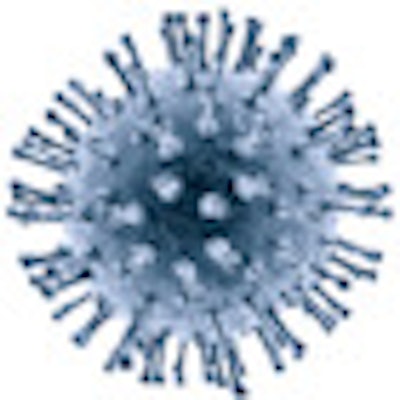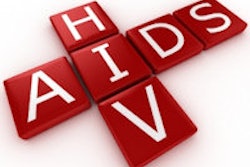
More than 33 million people worldwide were living with HIV/AIDS at the end of 2008, according to the World Health Organization. Compared to nine countries in Africa, where prevalence looms between 10% and 26% of the population, in North America HIV/AIDS has become a predominantly chronic condition (0.6% prevalence), thanks to the help of highly active antiretroviral therapy and public health campaigns.
And yet, the U.S. Centers for Disease Control and Prevention estimates that one in five HIV-positive Americans do not know they are infected.
"The main problem in the U.S. is that patients are presenting too late in the disease spectrum," said David Reznik, D.D.S., chief of dental service at Grady Health System and founder of HIVdent, an online HIV/AIDS oral healthcare information resource. "If people get tested and linked to care earlier, then they're going to have better outcomes. The antiretroviral therapy is going to be more effective. And when people know their status, they are 70% less likely to put others at risk, so you help stop the spread of the disease."
Dentists can play a key role in this, added Dr. Reznik, noting that 10% of the population visits a dental office every year but do not visit a medical office, and that 3.6 million Americans at significant risk of HIV have never been tested. Three-fourths of these people have seen a dentist within the past two years, he said, and each of these visits represents an opportunity for education and screening.
Opportunistic infections
The mouths of individuals with HIV and AIDS can be read to indicate severity of disease progression and possible treatment failure, according to a recent article in the Australian Dental Journal (June 2010, Vol. 55:1 Suppl., pp. 85-102). As the immune system weakens, an HIV or AIDS patient becomes more vulnerable to any kind of infection, and many of these infections occur first in the mouth, according to lead author Newell Johnson, B.D.S., M.D.Sc., Ph.D., a professor of dental research at the Griffith University School of Dentistry and Oral Health.
"The range of opportunistic infections (OIs) in the mouth are more common in HIV-positive patients; the type, number, and severity being proportional to degree of immunosupression," he stated in an e-mail to DrBicuspid.com.
“When people know their status, they are 70% less likely to put others at risk.”
— David Reznik, D.D.S., Grady Health
System
With decreased CD4 counts, various OIs that would normally be held at bay by a healthy immune system are able to emerge in the patient's body, often in the mouth. Oral OIs include candidiasis and other fungi, tuberculosis, human herpesviruses (HHV) and human papillomaviruses (HPV), herpes zoster, Kaposi's sarcoma, and oral hairy leukoplakia, according to Dr. Johnson. These infections and numerous others can all be indications of untreated HIV infection or treatment failure. Herpesviruses have been shown to manifest as OIs at CD4 levels of 300-315, whereas oropharyngeal candidiasis and oral hairy leukoplakia show up often around CD4 levels of 200.
In addition to OIs, xerostomia is a common problem in HIV patients, both from the medications they take and the disease itself. This can lead to discomfort and also contribute to caries development and oral candidiasis. Reinforcement of oral hygiene is very important for HIV-positive patients.
"For the most part, if you have an undetectable viral load, you shouldn't present with an oral lesion," Dr. Reznik said. "In the beginning of this epidemic, 80% to 90% of patients presented with some oral manifestations of HIV disease. That's not the case anymore. However, we still see more oral candidiasis than in the general population. We're seeing salivary gland disease. We're seeing oral warts from HPV infection, and there's concern that we're going to see an increase in squamous cell carcinoma because we're seeing so much of the oral wart problem."
|
HIV/AIDS lab values The human immunodeficiency virus (HIV) primarily attacks CD4 T-cells, hijacking the cellular machinery of the CD4 cell to make more copies of the virus instead of allowing it to perform its usual duties in the immune system. These copies of the HIV virus then go on to take over other CD4 cells. As this happens, the number of functional CD4 cells goes down (mean CD4 count) and the number of viral copies (the viral load) goes up. The goal of HIV treatment is to keep the CD4 level high and the viral load low or nondetectable. A normal CD4 count is 500-1600/mm3. Acquired immune deficiency syndrome (AIDS) is defined as having a CD4 count under 200. Previous treatment guidelines recommended starting antiretroviral treatment (ART) at CD4 levels of 350, but the International AIDS Society-USA Panel now recommends starting treatment if the patient's CD4 is as low as 500. |
Understanding basic lab values such as CD4 count and viral load is important for dentists in order to better understand an HIV/AIDS patient's disease process, Dr. Reznik noted. He advises against premedicating for dental procedures based on CD4 counts, stating a lack of evidence, although he does think that it's advisable to premedicate for an absolute neutrophil count (ANC), another measure of immunity, of 500 or less. Normal is more than 1,500 cells/µL. He advises HIV-positive patients to bring current lab results to their dentist, but to never let lack of availability of lab data be a barrier to care.
Some U.S. dental offices have begun offering rapid HIV testing using the OraQuick Advance rapid HIV-1/2 antibody test (OraSure Technologies). The test can be performed by anyone easily trained to do so, with results ready in 20 minutes. There is no need to draw blood on people afraid of needles or have patients return for lab results.
Dr. Reznik encourages dentists to use this available technology. "Will we utilize a technology for this fluid that we're most familiar with, or will we hand it off to outreach workers and medical offices and not take advantage of it?"
Infection control in the dental setting
Although there is more understanding about the means of the virus' transmission than in the early days of the epidemic, some healthcare providers remain afraid of working with HIV patients. But Dr. Johnson insists there is very little risk to the dental team.
"The risks of the dentist acquiring HIV from a patient, of transmitting it to a member of staff or another patient are almost nonexistent, provided high-quality infection control and hygiene procedures are employed," he said. "Procedures for the prevention of cross infection must be at a standard to prevent transmission of all bloodborne viruses, amongst which HIV is by no means the most easily transmitted."
There is also a fear of transmission of HIV to patients from HIV-positive providers. Dr. Johnson notes in his article that there was only ever one suspected case, in 1987, of an HIV-positive dentist possibly transmitting HIV to a patient, and that the mode of transmission has never been established. And in 2009, at the Global Challenge 6th World Workshop on Oral Health and Disease, global professionals established the Beijing Declaration, stating their belief that HIV-positive dentists should be allowed to practice even invasive procedures, provided that standard precautions are followed and that their health, tactile, and cognitive skills are monitored by an appropriate physician.
The recent International AIDS Conference, held July 18-23, 2010 in Vienna, Austria, drew more than 19,000 participating clinicians, researchers, and activists from all over the world. In honor of the event, the entire July 21 issue of the Journal of the American Medical Association (Vol. 304:3) was devoted to the subject of HIV/AIDS, and the message from both the conference and the journal was clear: Get patients into care earlier to decrease transmission and improve treatment outcomes.
Copyright © 2010 DrBicuspid.com



















